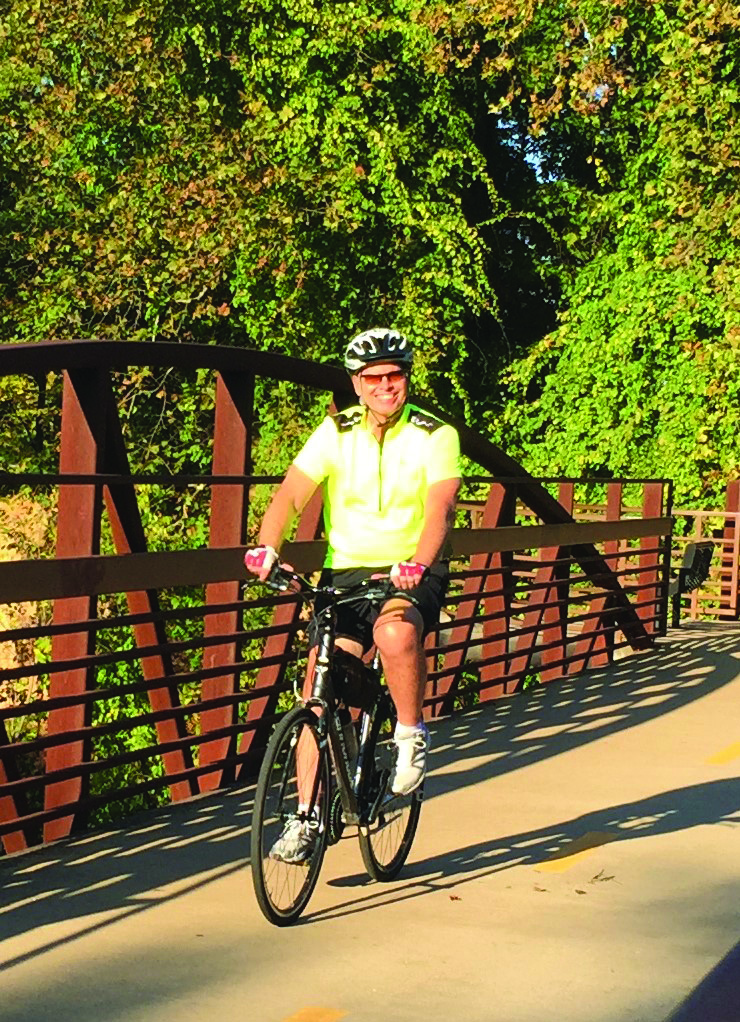A Second Chance
Explaining the benefits of Dr. Richard Berger’s minimally invasive joint replacement surgery versus traditional replacement surgery can sometimes be a bit tricky to quantify. Traditional joint replacement means the physician makes a large incision and cuts through the major muscles and tendons of the joint to remove the arthritic bone and insert the prosthesis. Dr. Berger’s minimally invasive technique allows him to work through a small incision, and spare the surrounding muscles and tendons of the joint while performing the replacement surgery. One patient is acutely aware of the difference Berger’s surgery can make: Michael Hill, an avid biker in his early sixties, who had both knees replaced in 2016. The right knee was replaced via the traditional method on June 14th and on September 14th he had his left knee replaced minimally invasively by Dr. Berger.
Michael Hill first heard of Dr. Berger after a phone conversation with his sister-in-law, Areta McKenzie. Areta explained that she would be undergoing minimally invasive surgery with Dr. Richard Berger in Chicago and would be flying home 48 hours after surgery. This sounded not only improbable, but also impossible to Michael for he himself had just undergone traditional knee replacement with a doctor in his home state of Arkansas, two weeks before this phone conversation.
He was just beginning a very arduous recovery process, and the thought of navigating airport security, walking the terminals, and feeling well enough to fly 48 hours after replacement surgery sounded so unlikely that Michael assumed Areta was mistaken.
After that phone call, he continued to focus on his recovery, which was slow going. Mentally, it took about 10 days for Michael to feel normal after the general anesthesia he had during traditional surgery and he felt woefully bored by the amount of time he had to spend just sitting around. Physically, he needed a walker for the first three weeks after surgery and a cane for a week after that. It took a couple of weeks before he could shower, a month for Michael to be able to bend his knee enough to sit comfortably at a table, and six weeks before he got back behind the wheel of his car. Two months after surgery, Michael finally felt comfortable going up and down stairs and, lastly, it was 10 whole weeks before Michael was able to return to the bike he loves. Even then, he managed to go only 5 miles before needing to rest.
During this time, Michael relied heavily on his wife, Jeanie Hill, who said the amount of attention Michael required after his surgery made her feel “like I had a newborn baby at home.” Jeanie had to clean his staples, change his dressing, administer shots, and care for him extensively after his traditional knee replacement.
Unfortunately for Michael, he had advanced arthritis in both knees and was facing a second surgery on his right knee. He wanted to put off the second surgery far enough into the future for him to be able to forget the grueling and burdensome recovery process of the first. Remembering his phone conversation with his Areta, he began to research Dr. Berger and read about the dramatic difference in recovery time Dr. Berger’s method makes. While both skeptical and hesitant, Michael was also curious. He decided it was worth a visit to Chicago, and met with Dr. Berger for a consultation.
After meeting Dr. Berger and the team, Michael scheduled his right knee replacement with Dr. Berger. The postoperative experience with Dr. Berger was dramatically different; immediately after surgery, Michael said he was doing “normal” things. He enjoyed a shower the morning after surgery, and was already able to bend his knee enough to sit at a table and join his wife for breakfast at the hotel.
One week after surgery, he was driving again and was able to stand unassisted long enough to usher at church. Two and a half weeks after surgery, he flew back to Chicago by himself for his follow up appointment and the crowning achievement: three weeks after surgery, he got back on his bike and rode 10 miles.
Michael was not the only individual astounded by the drastic difference in his recovery after surgery with Dr. Berger; the experience for Jeanie was drastically different, too. There were no shots to administer or dressings to change. She had officially been relieved of her nursing duties. Jeanie said she felt as though Michael was so functional that she could actually leave the house without worrying about him.
For the Hills, understanding the difference between traditional joint replacement and minimally invasive joint replacement surgery is simple. The former, they would like to forget. The latter “felt like a vacation” by comparison.

